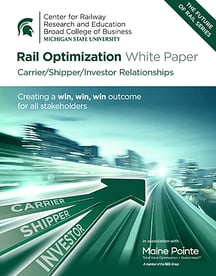Rail Optimization: The Imperative for Change
Background
Recent years have seen bold patterns of economic growth, a decline in traditional rail freight traffic and an increase in road/rail intermodal traffic. This has taken place against an efficiency backdrop of improved asset utilization, operating ratio and shareholder returns for railroad companies, especially the Class 1 railroads. However, railroad shippers, customers and investors remain concerned.
The rail industry's investment in infrastructure, motive power availability and manpower, to name but three elements of the complex railway ecosystem, has shown major swings. Output metrics, with one major exception, have barely improved (and in some cases fallen) over time. Carload journey times remain much as they were 20, 50, or more years ago. Increases in unit and manifest train length have possibly contributed to recent network congestion. Intermodal trains have taken on the guise of express freight, adding to the complexity of operations. At the same time, trucking rates increased due to driver shortages and regulatory changes -- a missed opportunity for modal shift in favor of railways.
Looking forwards, the US Department of Transportation expects freight tonnage across all modes to grow almost 40% by the year 2045. Congestion on our highways cannot cope with this additional volume, so rail and other modes will have to step up and create extra capacity.

Communication and relationship changes
In the last few years, a communication challenge between the shipper and carrier has deepened, to the point where, it is frequently dysfunctional. Carriers have experienced a financial golden age that many shippers believe was achieved on the back of their community. Wall Street has rewarded carriers for driving down their Operating Ratio (OR) on the “cost“ side, but has become skeptical over this as the sole KPI. On the shipper side, we have seen a journey from anger to disgust to acquiescence and almost a desperation to find any alternate mode to avoid dealing with rail carriers. This is evidenced by the continuing fall in rail's market share.
Data-driven analytics and decision making, stemming from technologies and improvements enabled largely by Positive Train Control (PTC) implementation should give the rail industry a platform for service improvement, better information, planning and preparedness. Disruptive technologies applied to freight transportation, will significantly alter the cost structure underpinning modal choice for some freight traffic. Railroads have demonstrated their capability to deliver at the right cost, yet there is considerable reticence towards forging relationships based on open communication, visibility of data, and underpinned by long term trust, value creation and environmental sustainability.
Interviews with key stakeholders conducted for our recent rail optimization white paper identified the drivers of successful relationships between railroads, shippers, customers, suppliers, and also between the long distance, heavy-haul Class 1 networks and their Class II and Class III shortline partners. A key outcome of this research was the identification of transformational change in the way multilateral relationships are developed and maintained to the benefit of all stakeholders.
The current state of integrated supply chains involving movement to rail
Supply chain research has generally focused on freight transportation by truck and air. Rail and barge have been deemed more suitable for heavy, bulky materials. These would be inherently uneconomic and environmentally unacceptable to move long distances by road. However, as the structure of the economy becomes more service and consumer oriented and grows in overall size, buying behaviors and freight traffic patterns are changing. At the same time, environmental considerations are increasing and supply chains are becoming longer. This increasing complexity is driving the need for a more effective and efficient transportation system.
Stakeholder perspectives
So, how do the individual stakeholders in the rail transportation supply chain view this changing landscape? What are their key concerns, and how can they work together to drive greater collaboration and improve relationships to create a buy-make-move-fulfill supply chain which is equipped to meet the needs of the 21st Century? As this series of blogs continues, we will explore the shippers' and carriers' perspectives and discuss how they can collaborate to create a scenario where everybody wins.
Read the MSU rail optimization white paper
 Click here to download the full Rail Optimization research white paper by Michigan State University Center for Research and Education, Broad College of Business, in association with Maine Pointe.
Click here to download the full Rail Optimization research white paper by Michigan State University Center for Research and Education, Broad College of Business, in association with Maine Pointe.
About Maine Pointe
Maine Pointe, a member of the SGS Group, is a global supply chain and operations consulting firm trusted by many chief executives and private equity firms to drive compelling economic returns for their companies. We achieve this by delivering accelerated, sustainable improvements in EBITDA, cash and growth across their procurement, logistics, operations and data analytics. Our hands-on implementation experts work with executives and their teams to rapidly break through functional silos and transform the buy-make-move-fulfill digital supply chain to deliver the greatest value to customers and stakeholders at the lowest cost to business. We call this Total Value Optimization (TVO)™.
Maine Pointe's engagements are results-driven and deliver between 4:1-8:1 ROI. We are so confident in our work and our processes that we provide a unique 100% guarantee of engagement fees based on annualized savings. www.mainepointe.com
About MSU
MSU is consistently ranked as the #1 undergraduate and graduate school for supply chain management education and recruitment. MSU is also home to a long-established Railway Management educational program. MSU's Eli Broad College of Business is home to the Center for Railway Research and Education. The Center focuses on the management of all aspects of the complex railway ecosystem from infrastructure to motive power, safety to talent, financing to rolling stock and technology to control systems for both passenger and freight railways. The synergy of these two world-class areas of expertise is unique.
